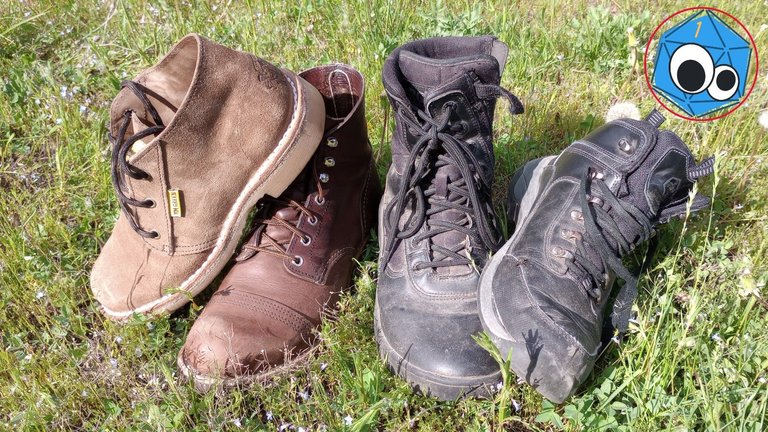I have written twice already about my ongoing efforts to find a replacement for the cheap boots and shoes I have been wearing with growing dissatisfaction for years. This has also led to trying to learn more about how boots and shoes are made, what benefits and drawbacks various materials offer, and why features we take for granted exist in the first place. Fashion is lower than functionality in my priorities, so I want to know what footwear serves my needs most.

Photo by me. Left to right: Jim Green Vellie, Red Wing Iron Ranger, a cheap "tactical" boot, and a cheap Costco shoe.
First, I'll share some boring backstory. Then, a few paragraphs down, I'll get to the point. That's how the recipe posts work, right? Why would they tell you how to make a casserole right away when they can begin with the emergence of the dinosaurs and explore tangents about Regency-era etiquette before rambling on about the kids first? Let's give that a try, only this is about boots and shoes instead of fine cuisine.

My first recognition of shoe sole materials dates all the way back to childhood when I learned my black-soled Reeboks (or whatever brand those athletic shoes were) made marks on my mother's floor. More specifically, she discovered this, and decided it was not OK. It was my job to clean them, and it is also at this time I learned I had a chemical sensitivity to several cleaning agents. And of course then it became a problem of convincing my parents it was a real issue, and not just slacking off on an unwanted chore.
Over the years, I learned to look out for "non-marking soles," but assumed the wear cycle of cheap sneakers was just part of wearing shoes. And to be fair, some of that might have been due to false economy of buying cheap shoes, but I tended to get reasonably reputable (if less stylish) shoes. I never had Nike Air Jordans or Reebok Pumps, but I recall basic Reebok cross-trainers, New Balance running shoes, and the like. End-of-season clearance sales were a big part of budgeting, and this was largely before the flood of cheap Chinese goods swamped every industry. Still, there was always the problem of sole layers delaminating or the upper breaking away from the sole when stitching or glue failed.
As I reached adulthood and spent more time working office jobs and manual labor, I had less need of athletic shoes and more need for something that could fit in with either business casual or blue collar work. That's why I settled on the disposable black "tactical" boots from the local sporting goods store. They looked just unassuming enough to be overlooked in the office settings I knew, and helped add traction for excursions to job sites or when winter weather added traction trouble for those with proper dress shoes. As they lost their sheen, they were transitioned to chores, outdoor work, and hiking use because their tread was still good and the upper was still functional even when the cheap plastic topcoat started to look less presentable. It was an affordable solution that seemed to make sense at the time, but one must always be ready to examine what has been taken for granted and see whether it really works.

Even with men's boots, there is the question of heel or no heel. Men's dress shoes usually have a small defined heel, and I defer to The Art of Manliness for what kinds to wear in more formal circumstances. Ladies, you're just on your own when it comes to fashion. I'm interested in very utilitarian matters. In any case, A good boot or shoe is built for a purpose.
Boot and shoe soles can be made many different ways. Most mass-produced brands use one or more kinds of foam, and add a natural or synthetic rubber shell to hold the tread pattern on the bottom. The materials are usually not renewable or repairable, so these are purely consumable goods. However, thesy do offer benefits for many activities. Foam is soft, squishy, and comfortable for walking. Multiple densities of foam and rubber can help athletes push their limits without losing traction on the trail or on the court. These shoes can be remarkably lightweight, too. Some are stitched and/or glued to the upper, while others are formed with injection molding which welds the separate parts together. Modern synthetic shoes are an engineering marvel whether you like them aesthetically or not.
Some athletic shoes look back to earlier designs, and instead use a rubber cup sole that wraps up high enough to glue or stitch the upper from the side. Think of the classic Chuck Taylor All-Stars.. They were long gone from professional basketball by the time I was born, but were (and still are) popular as a casual shoe. Shoes of this style can range from cheap knockoffs to purpose-built shoes built even better than the original. The sole is not the most ergonomic, but that can be remedied with better insoles. These can also sometimes be resoled, although cost can be prohibitive to the point that just buying a new pair makes more sense unless it's a high-end shoe.
More traditional boots and shoes are built with a leather midsole, and a separate rubber outsole is added to complete it. These are easiest for a cobbler to resole. New outsoles are readily available, and the process basically involves peeling off the old one and then gluing on a new one. This may or may not require extra preparation steps and sewing everything together again depending on how the boot is built and whether the outsole is also stitched in place.
Finally, arguably the most traditional boots and shoes are moccasin-based designs. Many "moc toe" shoes and boots are modern designs with extra stitching to fake the look, but some actually use separate pieces. A true moccasin has leather wrapping under the foot and up the sides to be stitched to an upper toe cap. For modern durability, these are usually stitched to a midsole and given a modern rubber outsole.

The best-known boot with a heel here in the US is the cowboy boot, and its main job is to secure the wearer's foot in a stirrup when riding a horse. Cowboy boots also usually have little tread, sometimes even just smooth leather, because they need to slide in and out of stirrups without too much friction for the foot or wear on the horse tack.
Here in the Pacific Northwest, the traditional logging boots have a significant heel as well. Loggers carry heavy loads and often hike up steep hills, so I assume this was developed over time for better support. Heels also help anyone who climbs ladders, including railroad, industrial, and construction workers. These professions all benefit from that notch helping lock the foot in place
Properly-built boots with a separate heel should have a steel, composite, or wood shank embedded in the sole. It serves two purposes. When standing on the ground, a shank distributes the wearer's weight over the gap between the heel and forefoot while supporting the arch. When riding a horse or climbing a ladder, the shank helps distribute that concentrated force from narrow stirrups or rungs across more of the wearer's foot.
Basketball shoes don't have heels, they have flat soles for traction and comfort. Work boots can be designed for the same purpose, too. More modern "tactical" boots are designed with some athletic activity in mind, and may be more flexible with little or no heel. Many work boots have a flat sole sometimes called a wedge sole. There may or may not be a shank inside these boots depending on price point and purpose. These boots are better for walking and standing.
Whatever form the outsole takes, tread pattern is also worth considering. The more aggressive the tread, the better a boot will be for mud, sand, and rocky terrain. US military surplus boots have had tread designed specifically to shed mud for over 50 years. Many boots use a version of the Vibram mini-lug sole or one of its imitators, and these work well for general purposes, although they can hold onto snow or muck more than I would like. A less-aggressive tread is better for wear indoors where carpet and tile dominate.

So, what kind of sole is best for you? I don't know. Find what fits your purpose, and then find what fits your feet. As always, I have to recommend Rose Anvil on Youtube for no-nonsense reviews... well, OK, there might be some nonsense, but that's deliberate. Some boot makers like Jim Green and White's Boots show off their materials, design choices, and processes as part of their advertisement campaign because they want to show why they are worth your hard-earned money. Reviews abound on various sites. Get informed, and then get some good boots. Be willing to spend some money, but understand that good footwear is indispensable when your livelihood or even your life can depend on it, and they probably won't get cheaper any time soon.


Wow... that is a lot of consideration for the kind of shoe to use. I suppose it makes sense to me from a Safety and Industry standpoint.
For myself, I just wear safety boots. Steel Cap, great thread, durable in wet and oily conditions. But I tend to wear them everywhere. If I go to the office or sometimes on off days where I am not super casual and need a decent shoe, I opt for the Safety Boots before sneakers or running shoes... unless I actually run!
I haven't worked at a job that required a safety toe, but that is definitely important in many industries. Do you have a preference for steel or composite?
I don't think I have a preference. The main thing I want is for the shoe to be comfortable... I spend so much time in them they feel like my most comfortable shoes.
I know my Jim Greens are from your country. I think they make a safety toe version of the Razorback boot. Do you know whether they are a good option?
They are? I don't know Jim Greens as a brand at all. lol.
I think this is their South Africa site. So far, I've been happy with their vellies, and sneak preview: I'm planning to write about their African Rangers soon. They aren't haute couture, but the seem well-made and sturdy. They aren't as well built as my Red Wings, but dollar for dollar, they seem like a very good value so far, and the simpler build is more comfortable. The last also fits my feet better than anything else I have tried, so I have a personal bias in that regard. They've been hyped up a lot by the work boot influencer scene I discovered while researching, but I think the hype is probably earned.
I honestly think the Razorbacks might be my choice for safety toe over Red Wing at this point if I needed a pair. Prices rose over the last 3 years, and the discount is over. Plus these are the standard version. But I like what I see inside.
[/unpaid shill]
Interesting! Man, you are going to hate me but I can't even tell you what brand my Safety Boots are. I will need to go look...
Hehe, the Razorback to me is a reliable fast transport that gets my Grey Hunters into position while gunning down valuable targets! Hahaha.
The Razordback to you is a reliable aid to manual transportation. 😜
Wow
I can’t say I don’t like boots but I don’t really get to wear them here. The Cowboy boots look familiar though
Nice one!